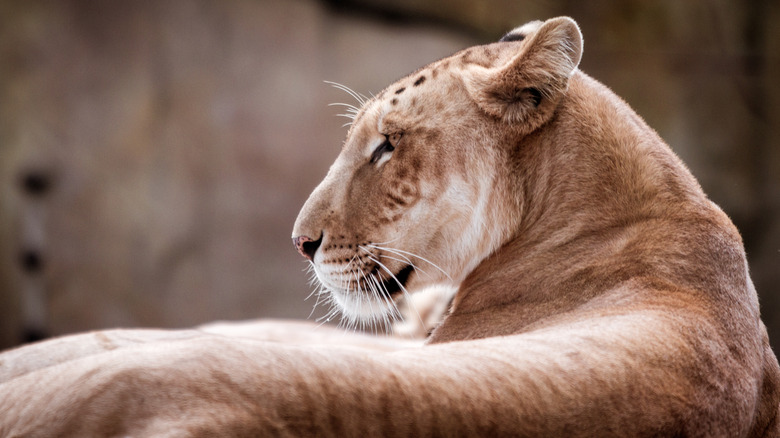The Difference Between A Liger Vs Tigon Explained
Lots of domestic animals are crossbred to make new breeds. Among dogs, for instance, a Siberian retriever is a cross between a Siberian husky and a Labrador retriever, while a cockapoo is a cocker spaniel and poodle mix. Many cat hybrids exist, too — such as a cross between a domestic cat with a small Asian leopard to create the Bengal cat or a domestic Abyssinian with a wild caracal to create a caracat. When it comes to larger animals, ligers and tigons are hybrids as well. Both of these breeds are the result of crossing lions and tigers but with one key difference: the male–female pairing.
Crossbreeding a liger requires a male lion and a female tiger, while a tigon requires a male tiger and female lion. Since lions almost exclusively inhabit the African continent and tigers live mostly across Asia, these cat species' habitats don't overlap. As a result, ligers and tigons don't occur naturally in the wild. Instead, their crossbreeding has been facilitated by humans, either accidentally in zoos or intentionally for entertainment and profit. And, it's nothing new: The first known breeding of a liger in captivity likely occurred in the late 18th century. But, while these types of genetic crosses look similar, ligers and tigons (oh, my!) each have their own characteristics.
The characteristics of a liger
Since the liger has a lion as its male parent, it takes on more interesting characteristics of the lion than its female tiger parent, however, features of both parents are present. For instance, the fur ranges from beige to a tawny-orange color, while the faint spots on its stomach and stripes on its back can range from sandy to dark brown to black. A male liger might roar and have a short, lion-like mane as well.
When it comes to size, a liger can be larger than both of its parents — measuring between about 10 and 12 feet long and weighing around 710 to 1,210 pounds. This crossbreed is also prone to obesity and gigantism, a condition where the body produces high levels of growth hormone that make it grow larger than expected. Biologists think that this health issue could be the result of the liger not having certain genes that limit its growth. That's why some ligers reportedly weigh more than 2,000 pounds.
On an interesting note, the liger has a bite force of around 900 pounds per square inch (psi), which is comparable to the 1,000 psi bite force of some adult lions. It eats up to 50 pounds of meat per meal, usually cattle, deer, and wild boar. During its 13-to-18-year lifespan, these animals are docile and gentle by nature. Also, the liger seemingly loves water — a trait that wild tigers have but lions don't — but it can take some time for it to take the leap.
The characteristics of a tigon
Like with the liger, the tigon takes on more characteristics and physical features of the tiger male parent than its lion female parent, although it has features of both. Fewer tigons than ligers exist in the world, so less information is available about this hybrid, however, the animal community has at least obtained data about its appearance and measurements. For starters, a tigon is a darker orange color than its counterpart, taking after its tiger father more than its lion mother. Its belly is usually white, and the spots on its belly, head, and feet and the stripes on its back, tail, and legs are much darker than a liger's markings.
When it comes to size, a tigon grows around 4 to 9 feet long and weighs between 200 and 500 pounds. That's quite a bit smaller than a liger — as is its bite force of about 400 to 450 psi — and about the same size or smaller than its male tiger parent. Scientists believe that tigons never grow bigger than their tiger and lion parents because growth-limiting genes from both species are passed down to the offspring. Additionally, these animals suffer from more chronic complications and disabilities from birth than their liger counterparts because of their large size as cubs, which also leads to a higher death rate among the infants and mothers.


